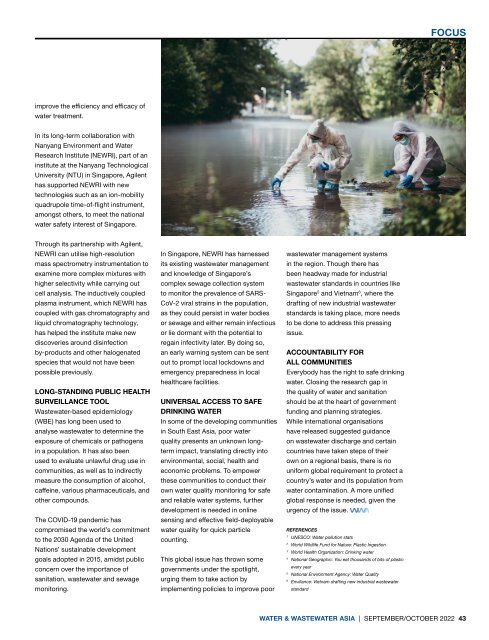Water & Wastewater Asia September/October 2022
Water & Wastewater Asia is an expert source of industry information, cementing its position as an indispensable tool for trade professionals in the water and wastewater industry. As the most reliable publication in the region, industry experts turn this premium journal for credible journalism and exclusive insight provided by fellow industry professionals. Water & Wastewater Asia incorporates the official newsletter of the Singapore Water Association (SWA).
Water & Wastewater Asia is an expert source of industry information, cementing its position as an indispensable tool for trade professionals in the water and wastewater industry. As the most reliable publication in the region, industry experts turn this premium journal for credible journalism and exclusive insight provided by fellow industry professionals. Water & Wastewater Asia incorporates the official newsletter of the Singapore Water Association (SWA).
Create successful ePaper yourself
Turn your PDF publications into a flip-book with our unique Google optimized e-Paper software.
FOCUS<br />
improve the efficiency and efficacy of<br />
water treatment.<br />
In its long-term collaboration with<br />
Nanyang Environment and <strong>Water</strong><br />
Research Institute (NEWRI), part of an<br />
institute at the Nanyang Technological<br />
University (NTU) in Singapore, Agilent<br />
has supported NEWRI with new<br />
technologies such as an ion-mobility<br />
quadrupole time-of-flight instrument,<br />
amongst others, to meet the national<br />
water safety interest of Singapore.<br />
Through its partnership with Agilent,<br />
NEWRI can utilise high-resolution<br />
mass spectrometry instrumentation to<br />
examine more complex mixtures with<br />
higher selectivity while carrying out<br />
cell analysis. The inductively coupled<br />
plasma instrument, which NEWRI has<br />
coupled with gas chromatography and<br />
liquid chromatography technology,<br />
has helped the institute make new<br />
discoveries around disinfection<br />
by-products and other halogenated<br />
species that would not have been<br />
possible previously.<br />
LONG-STANDING PUBLIC HEALTH<br />
SURVEILLANCE TOOL<br />
<strong>Wastewater</strong>-based epidemiology<br />
(WBE) has long been used to<br />
analyse wastewater to determine the<br />
exposure of chemicals or pathogens<br />
in a population. It has also been<br />
used to evaluate unlawful drug use in<br />
communities, as well as to indirectly<br />
measure the consumption of alcohol,<br />
caffeine, various pharmaceuticals, and<br />
other compounds.<br />
The COVID-19 pandemic has<br />
compromised the world’s commitment<br />
to the 2030 Agenda of the United<br />
Nations’ sustainable development<br />
goals adopted in 2015, amidst public<br />
concern over the importance of<br />
sanitation, wastewater and sewage<br />
monitoring.<br />
In Singapore, NEWRI has harnessed<br />
its existing wastewater management<br />
and knowledge of Singapore’s<br />
complex sewage collection system<br />
to monitor the prevalence of SARS-<br />
CoV-2 viral strains in the population,<br />
as they could persist in water bodies<br />
or sewage and either remain infectious<br />
or lie dormant with the potential to<br />
regain infectivity later. By doing so,<br />
an early warning system can be sent<br />
out to prompt local lockdowns and<br />
emergency preparedness in local<br />
healthcare facilities.<br />
UNIVERSAL ACCESS TO SAFE<br />
DRINKING WATER<br />
In some of the developing communities<br />
in South East <strong>Asia</strong>, poor water<br />
quality presents an unknown longterm<br />
impact, translating directly into<br />
environmental, social, health and<br />
economic problems. To empower<br />
these communities to conduct their<br />
own water quality monitoring for safe<br />
and reliable water systems, further<br />
development is needed in online<br />
sensing and effective field-deployable<br />
water quality for quick particle<br />
counting.<br />
This global issue has thrown some<br />
governments under the spotlight,<br />
urging them to take action by<br />
implementing policies to improve poor<br />
wastewater management systems<br />
in the region. Though there has<br />
been headway made for industrial<br />
wastewater standards in countries like<br />
Singapore 5 and Vietnam 6 , where the<br />
drafting of new industrial wastewater<br />
standards is taking place, more needs<br />
to be done to address this pressing<br />
issue.<br />
ACCOUNTABILITY FOR<br />
ALL COMMUNITIES<br />
Everybody has the right to safe drinking<br />
water. Closing the research gap in<br />
the quality of water and sanitation<br />
should be at the heart of government<br />
funding and planning strategies.<br />
While international organisations<br />
have released suggested guidance<br />
on wastewater discharge and certain<br />
countries have taken steps of their<br />
own on a regional basis, there is no<br />
uniform global requirement to protect a<br />
country’s water and its population from<br />
water contamination. A more unified<br />
global response is needed, given the<br />
urgency of the issue.<br />
REFERENCES<br />
1<br />
UNESCO: <strong>Water</strong> pollution stats<br />
2<br />
World Wildlife Fund for Nature: Plastic Ingestion<br />
3<br />
World Health Organization: Drinking water<br />
4<br />
National Geographic: You eat thousands of bits of plastic<br />
every year<br />
5<br />
National Environment Agency: <strong>Water</strong> Quality<br />
6<br />
Enviliance: Vietnam drafting new industrial wastewater<br />
standard<br />
WATER & WASTEWATER ASIA | SEPTEMBER/OCTOBER <strong>2022</strong> 43


















